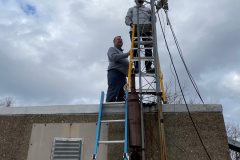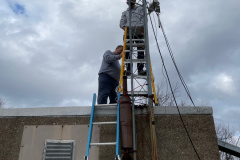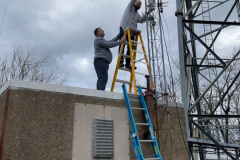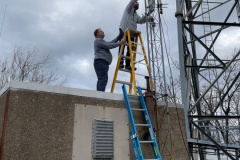
AREDN
MAWCG built an AREDN network for Amateur Radio Operators. The main nodes have been put up in Frederick MD. We will be expanding this network to cover a larger area. We are allowing interested radio operators to connect to the AREDN via RF or via an Internet tunnel.
This page has the latest details on the AREDN network, details about what AREDN is, how to get started, about our network and videos to learn more.
Overview
We currently have 2 nodes on top of Gambrill Mountain at the repeater site. One is a 2.4 Ghz Radio and the other a 5 Ghz Radio. The radios are Ubiquity Rocket M2 and Rocket M5 respectively.
Both radios are mounted on sector antennas that are aimed at 100 degrees from the site. This angle should cover Walkersville and down into Frederick Maryland.
Unfortunately the antennas at this location are currently only about 20′ off the ground. This will limit the coverage.
Both of these are ready for public use and open to any amateur that is interested.
We would like to expand this network over the area and build a network of amateur radio nodes. If you are interested, please let us know.
If you have an AREDN node and cannot reach any of the current nodes, we can connect your node via the internet and you can experiment with the cluster of nodes.
We are adding devices to the nodes so they can be used to experiment with how things work. As of this time, there is one camera connected to one of the nodes at the repeater site. Watch the news feed, twitter or discord to see when we add more devices.
This method is not good for emergency communications but works just fine for learning, testing and experimenting.
Contact us via the contact us page or via Discord to get setup to connect via the internet.
If AREDN is new to you, you can read below to learn a little more about AREDN.
Services We Have Setup
We are setting up some common services that are used in AREDN Mesh networks.
These services are there for everyone to learn and play with. Some of the tools have similar functionality. Different groups use different tools that do similar things, but we decided to put up the common tools.
| What | Status | Description | More |
|---|---|---|---|
| Camera | AVAILABLE | A Camera at the repeater site | |
| MeshMap | AVAILABLE | Draws a map of the nodes, their connections and services | |
| Wiki | AVAILABLE | A wiki that can be used to put documentation on for everyone to collaborate with | |
| MeshChat | AVAILABLE | A very simple chat program designed for Mesh Networks | |
| TeamTalk | AVAILABLE | Another Chat program that has video and audio | |
| Files | AVAILABLE | A file storage area to place files for anyone to have access to | |
| Citadel BBS | AVAILABLE | An old fashioned BBS converted to Web | |
| VOIP | AVAILABLE | WE have FreePBX up and running on the AREDN network. It connects to a larger system via IAX. | |
| MatterMost | 90% Complete | Another group chat with video, audio, screen sharing and more. Similar to Discord or Slack | |
| Weather | In-Progress | A weather dashboard |
If you have a service you think wold be good to add, let us know. If you connect up your node you can also create your own services that will be made available to the network.
Network
Overview
Below is a very high level of the network and services. Realtime information can be gotten from the MeshMap interface on the network.
The devices at the bottom are used in demonstrations are not currently put into full time use.

Mesh Status
Below is the Mesh Status as of July 16th. This has most of the demo hardware active when this screenshot was taken.
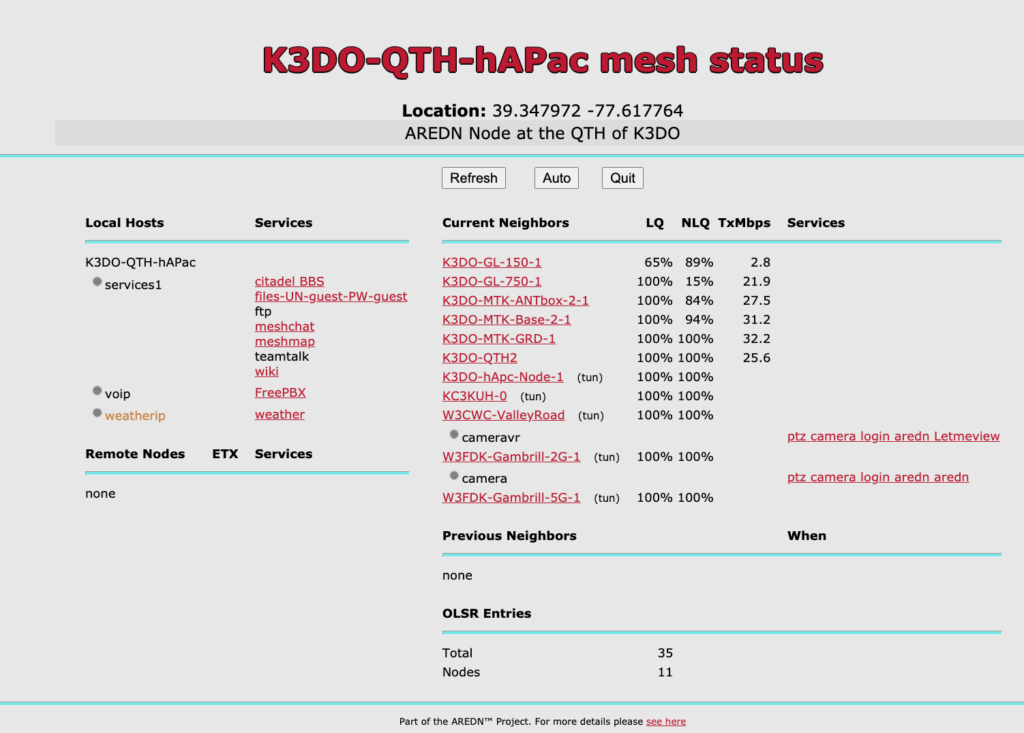
Mesh Map
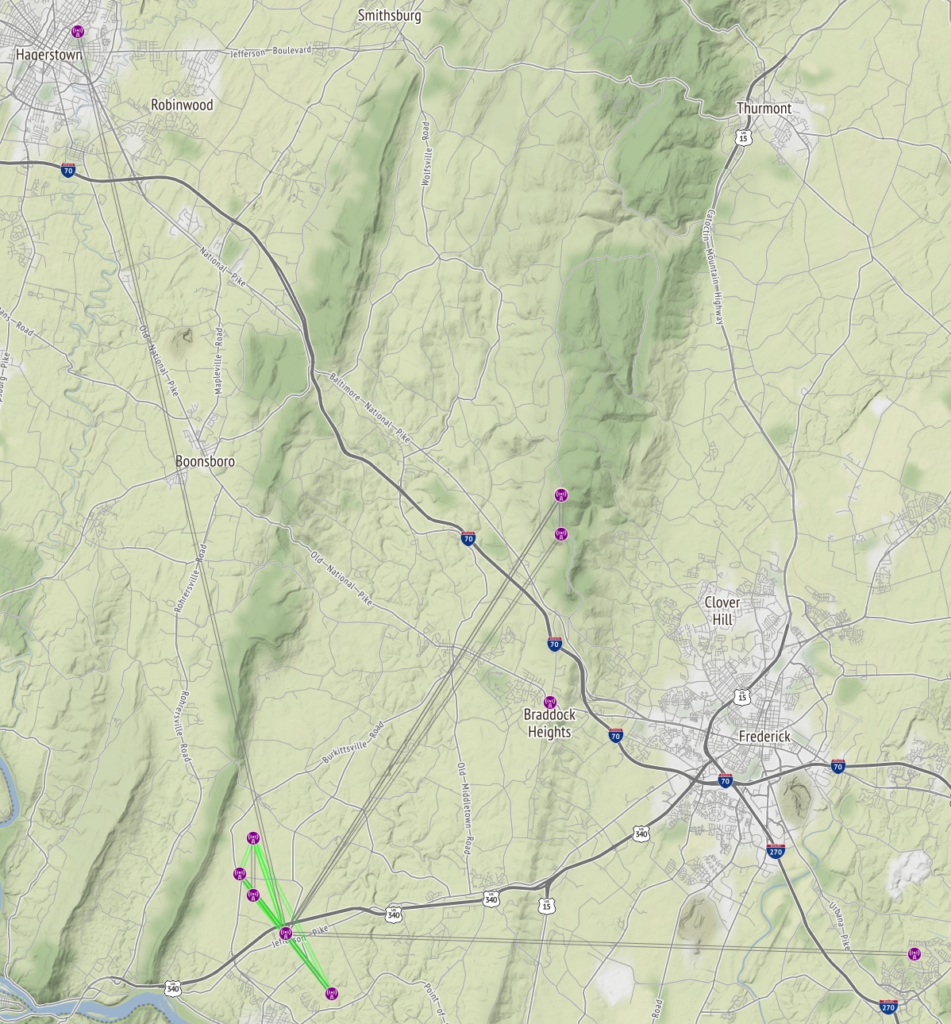
Compatible Hardware
The AREDN firmware is designed to run on devices that support OpenWRT firmware. This is a constantly changing list of hardware. Fortunately AREDN maintains a list of hardware. That list is linked below with some notes.
Compatible Hardware List
Here is a link to the AREDN compatible hardware list: https://www.arednmesh.org/content/supported-platform-matrix
You will notice that these are color coded. If you already have some Ubiquity gear of the Air series your device will probably work. But the devices that are in light green do not have much memory. If you are going to purchase something new, make sure it is dark green so that it has a longer lifespan with AREDN.
Compatible Hardware Links
There is a wide variety of hardware that supports AREDN. I am going to break it down by use case below with links to where you can purchase it.
Home use, mainly for experimenting with no direct RF link
- GL ARL150. Simple to setup and less than $30 (Has WAN and LAN Port with DTD on VLAN2 of LAN)
- GL AR750. Simple to setup. Has 3 ports for more experimentation with direct connections (WAN, LAN and DTD).
- MikroTik hAP ac lite. Has a dedicated WAN, DTD and 3 ports for LAN connections. Highest capacity for experimenting of the small devices.
Home use. Home to Wide Area Node (Point to Point)
- Ubiquity Powerbeam
- Ubiquity Nanostation M2 (Make sure if you are buying new it is the XW version)
- Ubiquity Nanostation M5 (Make sure if you are buying new it is the XW version)
- Microtik LHG XL 2 (2.4 Ghz 21 dbi point to point)
- Mikrotik LHG 5 ac (5 Ghz 24.5 dBi point to point or point to sector) ***
Wire Area Networking or Long Distance Point to Point
- Ubiquity Rocket M2 (2.4 Ghz)
- This is only the radio, You will need an antenna like:
- Ubiquity Rocket M5 (5 Ghz)
- This is only the radio, you will need an antenna like:
- Mikrotik mANTBox 2 12s (2.4 ghz 120 degree sector with built in radio)
- Mikrotik LHG XL 2 (2.4 Ghz 21 dbi point to point or point to sector)
- Mikrotik LHG 5 ac (5 Ghz 24.5 dBi point to point or point to sector) ***
- Mikrotik BaseBox 2 (2.4 Ghz)
- This is only the radio, you will need an antenna like:
- Laird Technologies SAH-2400-120 (120 degree sector)
- RocketDish 2 (long distance)
- Wide Area Sector (120 degrees)
- Wide Area Sector (90 degrees)
- This is only the radio, you will need an antenna like:
- Mikrotik Basebox 5 (5 Ghz) ***
- This is only the radio, you will need an antenna like:
*** – We have not tested these devices ourselves but they are on the AREDN hardware list
Getting Started
The quickest and least expensive way to get started experimenting is to grab one of the 3 devices in the home use experimenting section. If you do not consider yourself computer savvy then pick up one of the GL devices. They only take a few minutes to setup and only require the use of a web browser.
The other devices require the use of a tftf boot server to boot the device into a temporary boot image before you can flash the new firmware. It is not difficult but can be overwhelming to someone that is not familiar with it.
Once you get your device let us know and we can setup a tunnel for you. It is very simple, promise…. As soon as you connect to the tunnel you will have access to our entire AREDN network.
If you would like to connect to us via RF, we would love that too. We need to make sure that is a possibility from your location so please reach out and let us know. We have equipment we can bring out and confirm you can reach a node somewhere.
What is AREDN?
AREDN is an acronym that stands for Amateur Radio Emergency Data Network.
AREDN is a wireless mesh technology that uses off the shelf hardware to create a wireless mesh between access points.
There are people on both sides of the fence when it comes to AREDN.
Here are some Pro’s and Con’s:
Pros
- Uses Inexpensive off the shelf hardware that can easily be re-flashed with the AREDN firmware.
- Can use frequencies that are designated only for Amateur Radio so you are not competing with existing Wifi frequencies.
- Automatically builds a mesh between nodes it detects.
Cons
- Uses frequencies that are designated to Amateur Radio. This means that you cannot encrypt any data over the network. No SSH and no HTTPS.
- The mesh can many times not use the most efficient path between the mesh nodes.
- IP Addressing is confusing and not flexible.
There are probably many more on both sides but this is not about debating the value of AREDN because there is no doubt it has benefits.
You can learn more about AREDN by going to arednmesh.org
Videos
Below are some videos about AREDN. The first one is a little long but it has a lot of good information in it.
Pictures of the Install
Sandy (KC3EOF) and Kurt (K3KOH) putting up the sector antennas. Thank you guys, great job and much appreciated.

